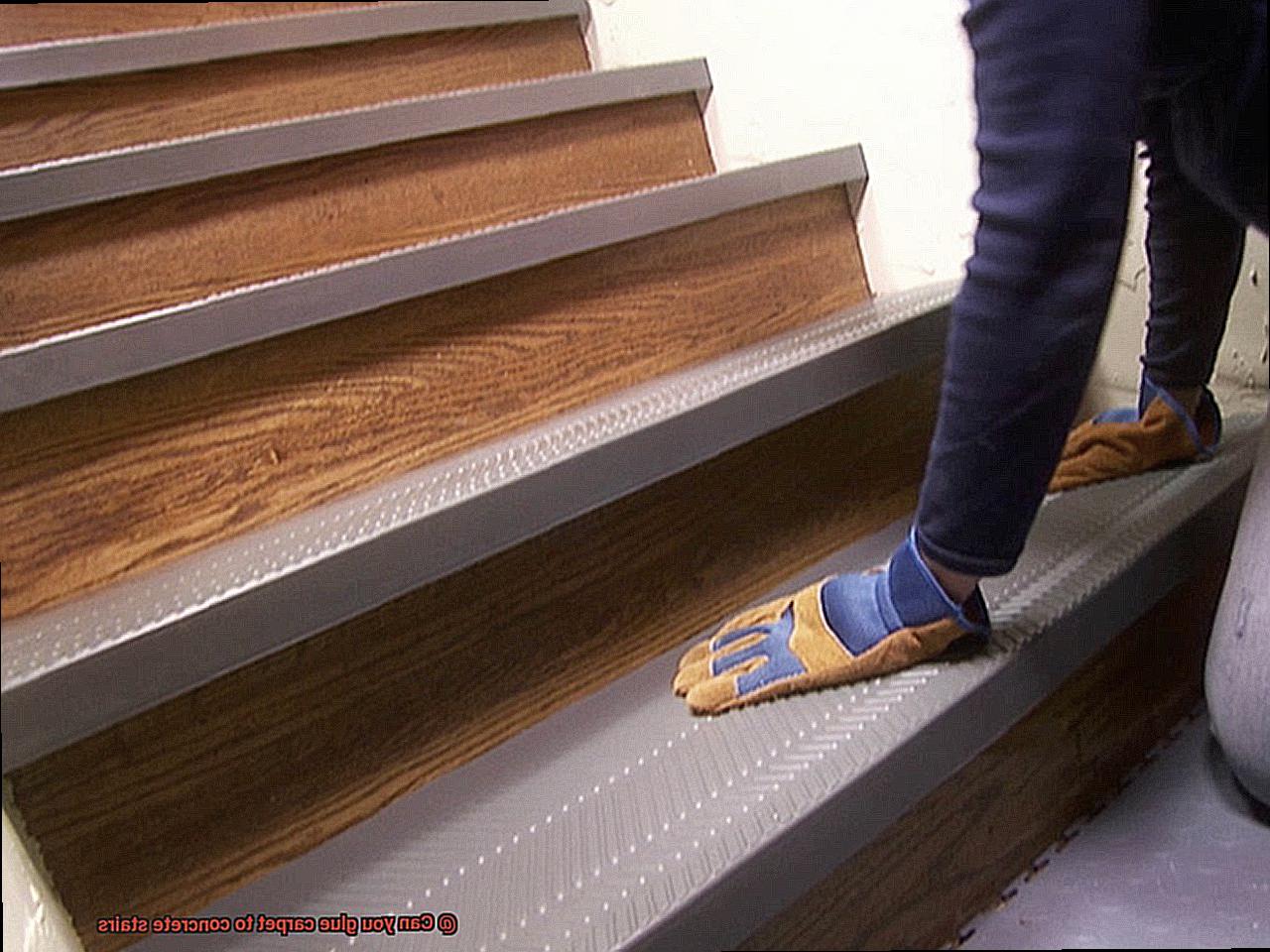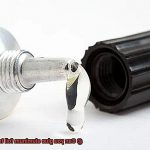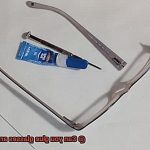Are your concrete stairs feeling a little cold and unwelcoming? Do you dream of adding a cozy touch to your space without breaking the bank? Well, wonder no more. Gluing carpet to concrete stairs is an incredibly popular and budget-friendly solution that can breathe new life into your staircase, giving it both practicality and style.
In this ultimate guide, we’ll explore the ins and outs of gluing carpet to concrete stairs. We’ll walk you through the necessary steps, materials, and techniques needed for a successful installation. Whether you’re a DIY enthusiast or considering hiring a pro, get ready as we unveil the secrets behind this transformative process.
Over the next few sections, we’ll discuss the advantages and potential challenges of this project, dive into the prep work required, explore different types of glue suitable for concrete surfaces, and provide valuable tips for achieving a long-lasting and visually pleasing outcome.
So let’s jump right in and discover how you can easily adhere carpet to your concrete stairs. Get ready to revamp your space, elevate its overall aesthetic, and enjoy the ultimate comfort in your home or office.
Preparing the Concrete Stairs for Glue Application
Contents
- 1 Preparing the Concrete Stairs for Glue Application
- 2 Understanding Different Types of Adhesives Used for Carpet Installation
- 3 Applying Primer to the Concrete Surface
- 4 Choosing the Right Adhesive for Bonding Carpet to Concrete
- 5 Applying the Adhesive with a Trowel or Notched Trowel
- 6 Laying the Carpet on the Stairs and Smoothing Out Any Wrinkles
- 7 Using a Roller to Securely Press Down the Carpet onto the Adhesive
- 8 Curing Time and Avoiding Walking on the Carpeted Stairs Until Fully Set
- 9 Conclusion
When it comes to gluing carpet to concrete stairs, proper preparation of the surface is key to achieving a successful installation. In this detailed guide, we will outline the step-by-step process of preparing concrete stairs for glue application. By following these steps, you can ensure a strong and durable bond between the carpet and the stairs, resulting in a seamless and long-lasting finish.
Step 1: Thoroughly Clean the Stairs
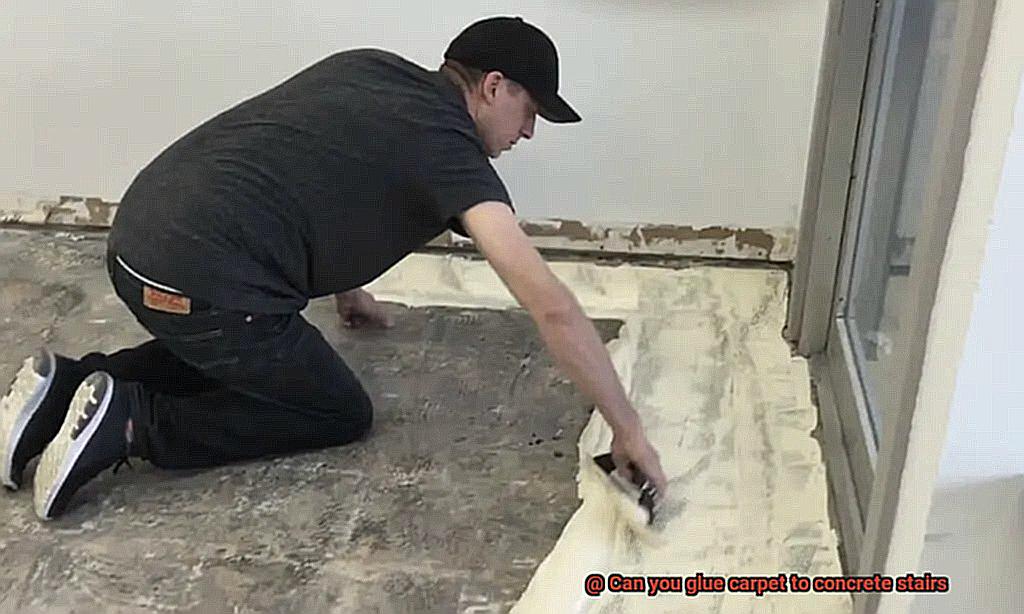
To begin, remove any loose dirt or debris from the stairs using a broom or vacuum cleaner. Pay close attention to the edges and corners where dirt tends to accumulate. Next, scrub the stairs with a mixture of warm water and mild detergent using a stiff brush or scrubbing pad. This will help eliminate stubborn stains or grime that may hinder the adhesive’s effectiveness.
Step 2: Rinse and Dry
After scrubbing, rinse the stairs with clean water to remove any soap residue, ensuring a clean surface for the glue application. Allow the stairs to dry completely before proceeding with the next steps.
Step 3: Repair Cracks and Uneven Areas
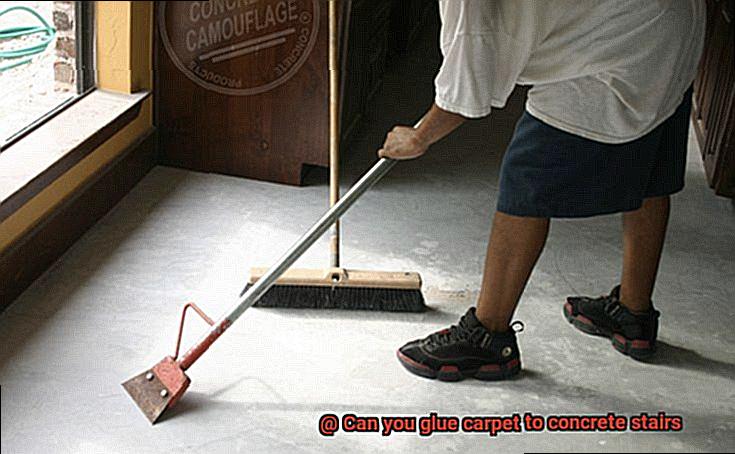
Inspect the stairs for cracks or uneven areas. If any are found, use a suitable concrete patching compound to fill them according to the manufacturer’s instructions. This will create a smooth surface for the carpet installation.
Step 4: Lightly Sand the Surface
Lightly sanding the surface of the stairs with fine-grit sandpaper is crucial for promoting better adhesion of the glue. This process helps roughen up the surface, allowing the adhesive to bond more effectively.
Step 5: Clean Again After Sanding
Thoroughly clean the stairs once more after sanding to remove any dust or particles created during the sanding process. Use a damp cloth or mop to ensure a pristine surface.
Step 6: Ensure Suitable Conditions
Before applying the glue, verify that the temperature and humidity in the area meet the manufacturer’s recommended requirements. This step is essential to ensure optimal bonding and prevent any issues during the installation process.
Understanding Different Types of Adhesives Used for Carpet Installation
Are you planning to glue carpet to your concrete stairs? If so, it’s crucial to choose the right adhesive for a secure and long-lasting bond. Let’s explore the different types of adhesives commonly used for carpet installation on concrete stairs, their benefits and drawbacks, and how to select the best one for your project.
- Contact Adhesive: A popular choice for carpet installation on concrete stairs is contact adhesive. This adhesive is applied to both the back of the carpet and the surface of the stairs, allowing them to bond upon contact. Contact adhesives offer a strong initial bond, making them ideal for heavy-duty carpets or high-traffic areas. However, their downside is that once applied, they can be challenging to reposition.
- Pressure-Sensitive Adhesive: Another commonly used adhesive for this type of installation is pressure-sensitive adhesive. This adhesive remains tacky, allowing for easy repositioning during installation. Pressure-sensitive adhesives work well for less heavy-duty carpets or areas where flexibility and adjustability are desired. However, they may not provide as strong of a bond as contact adhesives.
- Epoxy Adhesive: For outdoor carpet installations or areas prone to moisture exposure, epoxy adhesives are an excellent choice. These adhesives create an exceptionally strong bond between the carpet and concrete stairs and are highly durable and moisture-resistant. However, epoxy adhesives can be more challenging to work with and typically require special application techniques.
When choosing the right adhesive for your carpet installation on concrete stairs, consider factors such as the type of carpet, the type of concrete surface, and the specific requirements of your project. Consult with a professional installer or follow manufacturer guidelines to ensure compatibility with your materials.
Proper surface preparation is also crucial before applying any adhesive. Clean and prime the concrete surface to optimize bonding and prevent issues like delamination or carpet lifting.
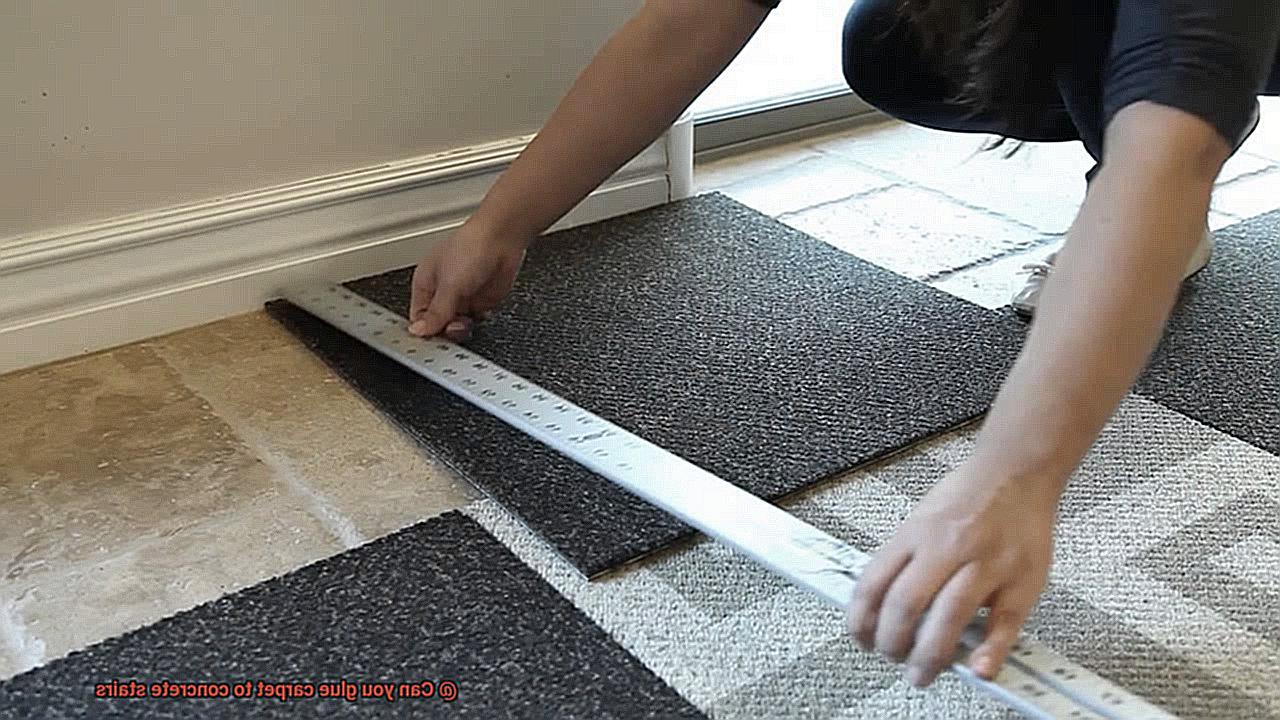
Applying Primer to the Concrete Surface
When it comes to gluing carpet to concrete stairs, applying primer to the concrete surface is a critical step that should never be overlooked. Primer serves as the foundation for a strong bond between the concrete and adhesive, ensuring that your carpet stays securely in place for years to come. In this comprehensive guide, we will provide you with step-by-step instructions on how to properly apply primer to a concrete surface, giving you the confidence to achieve a successful carpet installation on your concrete stairs.
Step 1: Prepare the Concrete Surface
Before diving into the application of primer, it is crucial to prepare the concrete surface properly. Take the time to thoroughly clean the stairs, removing any dirt, dust, or debris that may hinder the adhesion process. Sweep or vacuum the surface, or if needed, use a pressure washer for a deep clean. By starting with a clean canvas, you ensure that the primer adheres well and provides a strong bond.
Step 2: Choose the Right Primer
Not all primers are created equal when it comes to concrete surfaces. The type of primer you choose depends on various factors such as the type of carpet and the condition of the concrete stairs. Consult with your local home improvement store or seek professional advice to determine the best primer for your specific project. Options may include latex or epoxy-based primers that cater to different needs and preferences.
Step 3: Follow Manufacturer’s Instructions
To achieve optimal results, it is crucial to carefully read and follow the manufacturer’s instructions when applying primer. These instructions may include diluting the primer with water or using it as is. Some primers may require mixing before application. Armed with this knowledge, apply the primer evenly across the entire surface of the stairs using a brush or roller, ensuring comprehensive coverage.
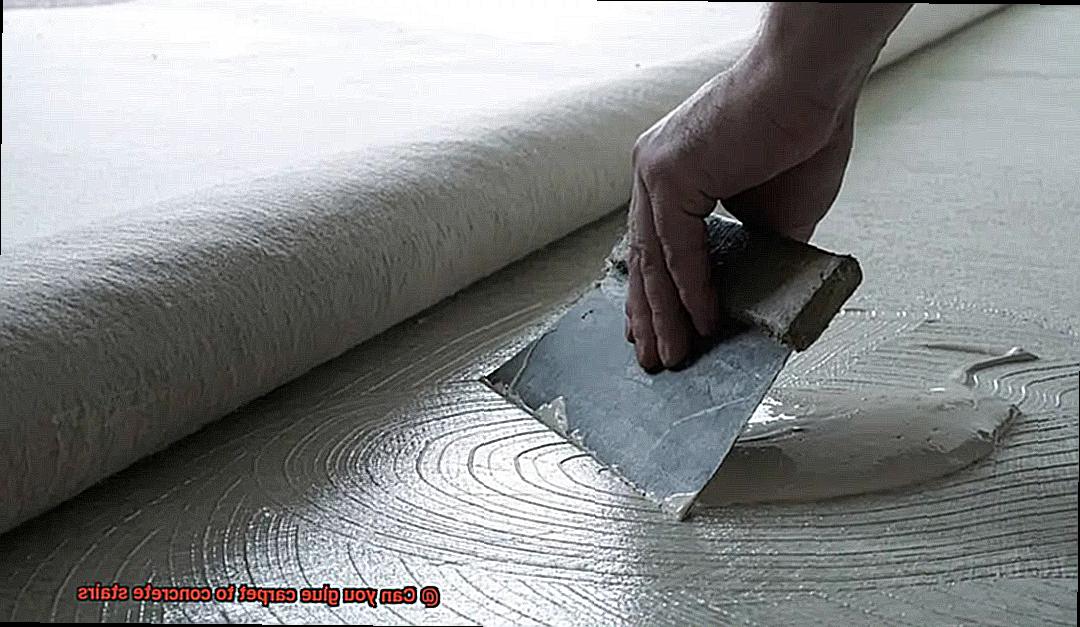
Step 4: Allow Ample Drying Time
After applying the primer, exercise patience and allow sufficient drying time as specified by the manufacturer. This vital step ensures that the primer fully bonds with the concrete surface, creating an optimal base for your adhesive. Typically, drying time can range from a few hours to overnight. Remember, rushing this process could compromise the integrity of the bond and affect the overall success of your carpet installation.
Step 5: Proceed with Adhesive and Carpet Installation
Once the primer has dried completely, you can move forward with applying your chosen adhesive according to the manufacturer’s instructions. Adhering to these guidelines ensures that you achieve the best results from your adhesive and create a secure bond between your carpet and the concrete stairs. Before installing the carpet, follow the adhesive manufacturer’s recommendations for application and drying time, allowing for a flawless installation.
Choosing the Right Adhesive for Bonding Carpet to Concrete
Selecting the right adhesive is crucial when it comes to bonding carpet to concrete. The adhesive you choose plays a significant role in the durability and performance of your carpet installation. To help you make an informed decision, here’s a step-by-step guide on how to choose the right adhesive and ensure a strong bond between carpet and concrete.
- Consider the specific requirements: Concrete is a porous material, so you need an adhesive that can penetrate the surface and create a secure bond. Look for adhesives specifically designed for bonding carpet to concrete.
- Types of adhesives: There are two common types of adhesives used for bonding carpet to concrete – solvent-based adhesives and water-based adhesives.
- Solvent-based adhesives: These contain volatile organic compounds (VOCs) that evaporate and create a strong bond. They have quick drying times and high initial tack.
- Water-based adhesives: These are more environmentally friendly with lower VOC contents. They offer good bonding strength and flexibility.
- Proper surface preparation: Before applying the adhesive, it’s essential to prepare the concrete surface properly. Clean it thoroughly to remove any dirt, dust, or debris that might interfere with the bonding process. Level or patch any uneven areas on the concrete if necessary.
- Follow manufacturer’s instructions: Use the recommended tools, such as a trowel or notched spreader, to evenly apply the adhesive across the entire surface of the stairs.
- Lay down the carpet: Carefully position the carpet over the stairs, ensuring it aligns properly and fits securely. Use a roller or hand tamper to press down on the carpet, ensuring good contact with the adhesive.
- Allow proper drying time: Follow the manufacturer’s instructions for drying time before allowing foot traffic on the stairs.
- Regular maintenance: Vacuum regularly and promptly address any spills or stains to maintain the appearance and integrity of the carpet.
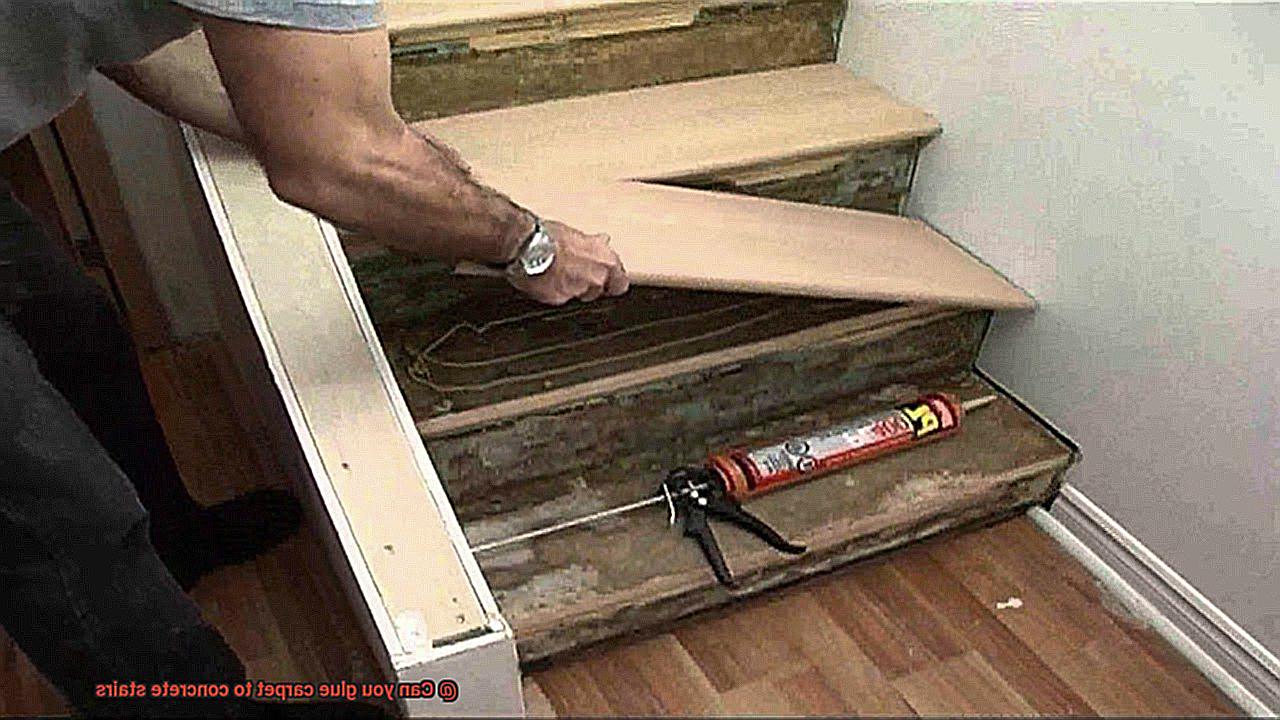
Applying the Adhesive with a Trowel or Notched Trowel
When it comes to gluing carpet to concrete stairs, there is a tried and true method: applying the adhesive with a trowel or notched trowel. This technique ensures that the adhesive is evenly distributed and creates a strong bond between the carpet and the stairs.
First and foremost, it is crucial to choose the right adhesive for the job. There are various adhesives available specifically designed for carpet installation on concrete surfaces. These adhesives are formulated to provide exceptional bonding properties and withstand the demands of foot traffic on stairs.
Once you have your adhesive in hand, it’s time to prepare the concrete stairs. This means ensuring that the surface is clean, dry, and completely free from any debris or loose particles. If there is any existing adhesive or paint, it must be removed as it can interfere with the effectiveness of the new adhesive. Additionally, take the time to repair any cracks or uneven areas before moving forward.
Now, let’s talk tools. The key to applying adhesive with precision is using a trowel or notched trowel. A trowel is a handheld tool with a flat, rectangular blade that is perfect for spreading and smoothing materials like adhesive. On the other hand, a notched trowel has teeth or notches along one edge, creating ridges in the adhesive that ensure even distribution and provide extra grip.
When using a trowel or notched trowel, it is essential to follow the manufacturer’s instructions regarding notch size and spread rate. Generally, a 1/8 inch square-notch or V-notch trowel will do the trick for carpet installation on concrete stairs. Take care to spread the adhesive evenly over the surface, making sure there are no gaps or puddles.
After applying the adhesive, it’s time to exercise some patience. Wait for the recommended open time before laying down the carpet. This open time allows the adhesive to become tacky but not fully dry, ensuring optimal bonding. Remember, the open time can vary depending on the specific adhesive, so always refer to the manufacturer’s guidelines for accurate information.
Once the open time has passed, it’s time to carefully position the carpet on the stairs. Make sure it is aligned correctly and press it firmly into place, allowing the adhesive to create a secure bond. To ensure proper adhesion and eliminate any air pockets or wrinkles, you can use a carpet roller or apply hand pressure.
Laying the Carpet on the Stairs and Smoothing Out Any Wrinkles
Laying carpet on stairs is an art that requires skill and attention to detail. When dealing with concrete stairs, the process becomes even more challenging. However, armed with the right materials and techniques, you can transform your staircase into a masterpiece. In this comprehensive guide, we will delve into the intricacies of gluing carpet to concrete stairs and reveal the secrets to achieving flawless results while smoothing out any unwanted wrinkles.
Preparing the Surface:
To lay carpet on concrete stairs successfully, it is crucial to start with a clean canvas. Thoroughly clean the surface, removing any dirt or debris that could compromise adhesion. Additionally, ensure that remnants of old carpet or adhesive are completely removed, creating a smooth and level playing field.
Choosing the Perfect Carpet:
Investing in high-quality carpet designed specifically for stair use is essential for durability and longevity. Look for carpets with a sturdy backing that can withstand heavy foot traffic. Accurate measurement and precise cutting of the carpet for each step is vital for a seamless installation.
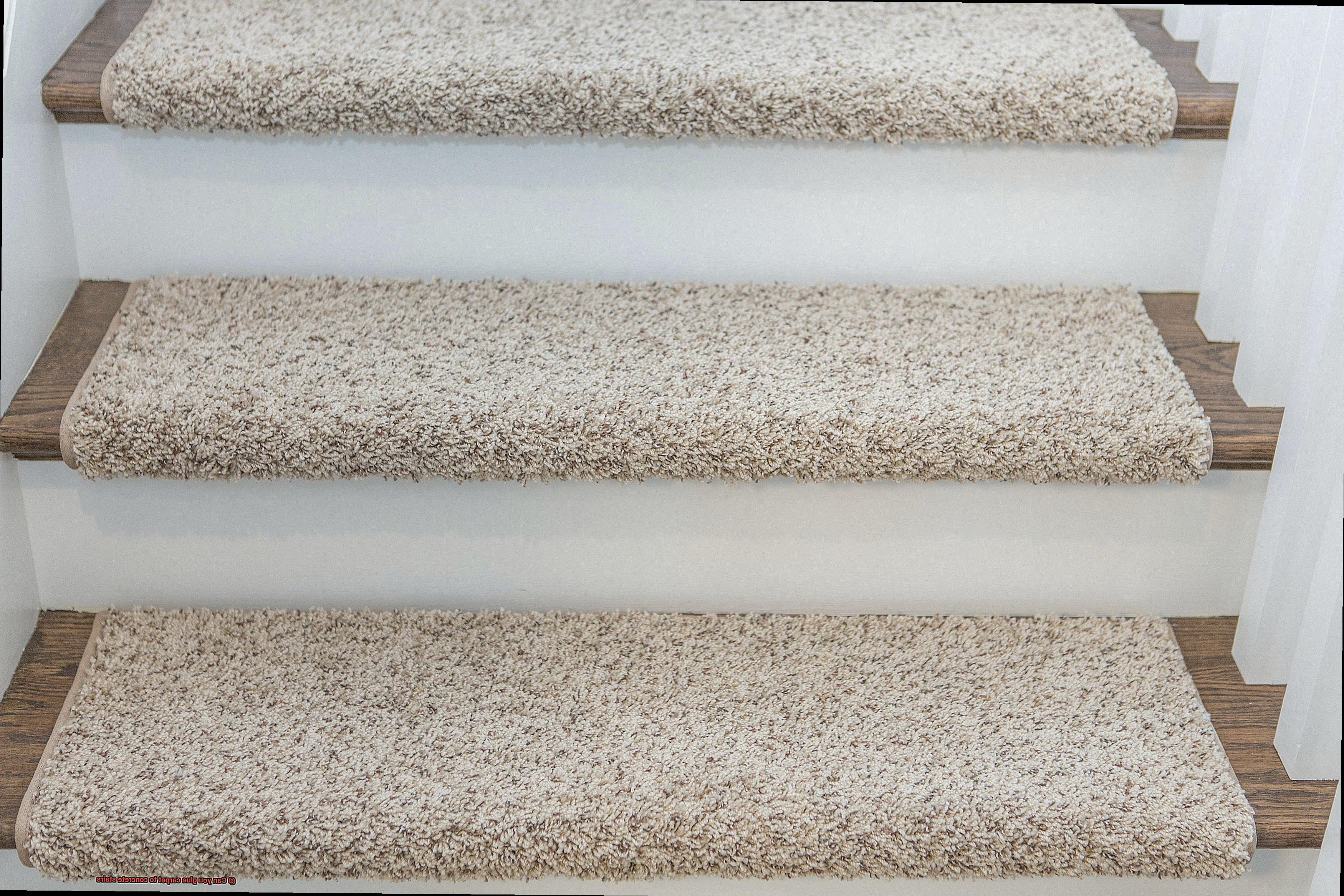
Selecting the Right Adhesive:
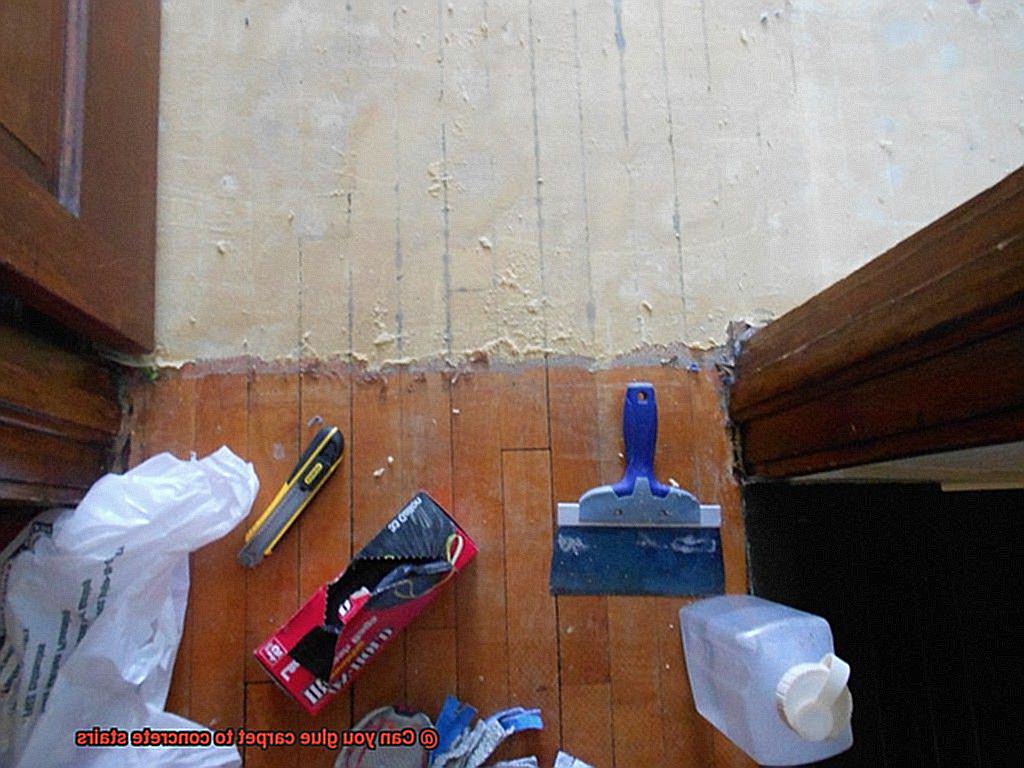
The choice of adhesive is paramount in ensuring a secure and long-lasting bond between the carpet and the concrete stairs. Opt for an adhesive specifically formulated for use on concrete surfaces. Carefully follow the manufacturer’s instructions, applying an even coat to the backside of the carpet.
Pressing the Carpet onto the Stairs:
Begin from the bottom step and delicately press the carpet onto the glued surface. To achieve optimal adhesion, employ a hand roller or similar tool, exerting firm pressure. Move methodically up each step, aligning the carpet precisely and eliminating any trapped air or unsightly wrinkles along the way.
Smoothing Out Imperfections:
If any wrinkles or uneven areas persist after installation, fear not. Employ powerful tools such as knee kickers or power stretchers to save the day. With their help, stretch the carpet tautly across each step, banishing imperfections and creating a flawlessly smooth finish that exudes elegance.
Safety First:
Throughout this endeavor, safety should be your number one priority. Protect yourself by wearing suitable gear such as gloves and goggles. Work in a well-ventilated space to minimize risks associated with adhesives and tools.
Allowing Ample Drying Time:
Patience is key when it comes to allowing the adhesive to dry completely. Rushing this stage could compromise the integrity of the bond. Give ample time for the adhesive to set before using the stairs, ensuring a secure and stable carpet that will withstand the test of time.
Using a Roller to Securely Press Down the Carpet onto the Adhesive
Transforming them with a beautiful carpet can add a touch of elegance and comfort to your space. But before you embark on this exciting project, it’s important to understand the significance of using a roller to securely press down the carpet onto the adhesive. In this section, we’ll dive into the proper technique for using a roller in this application.
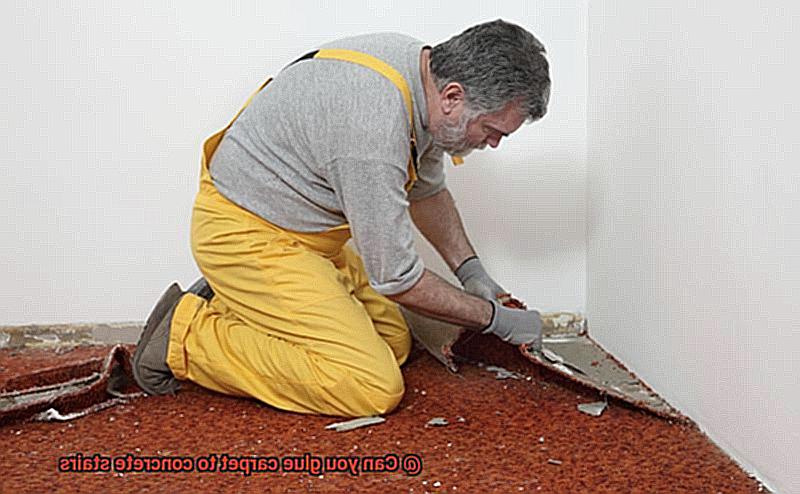
Choosing the right type of roller is the first step to success. Look for a carpet roller specifically designed for this task. These heavy and cylindrical rollers are equipped with a comfortable handle for easy grip and maneuverability. They are built to tackle the job of pressing down carpets onto adhesive surfaces, ensuring a smooth and even finish.
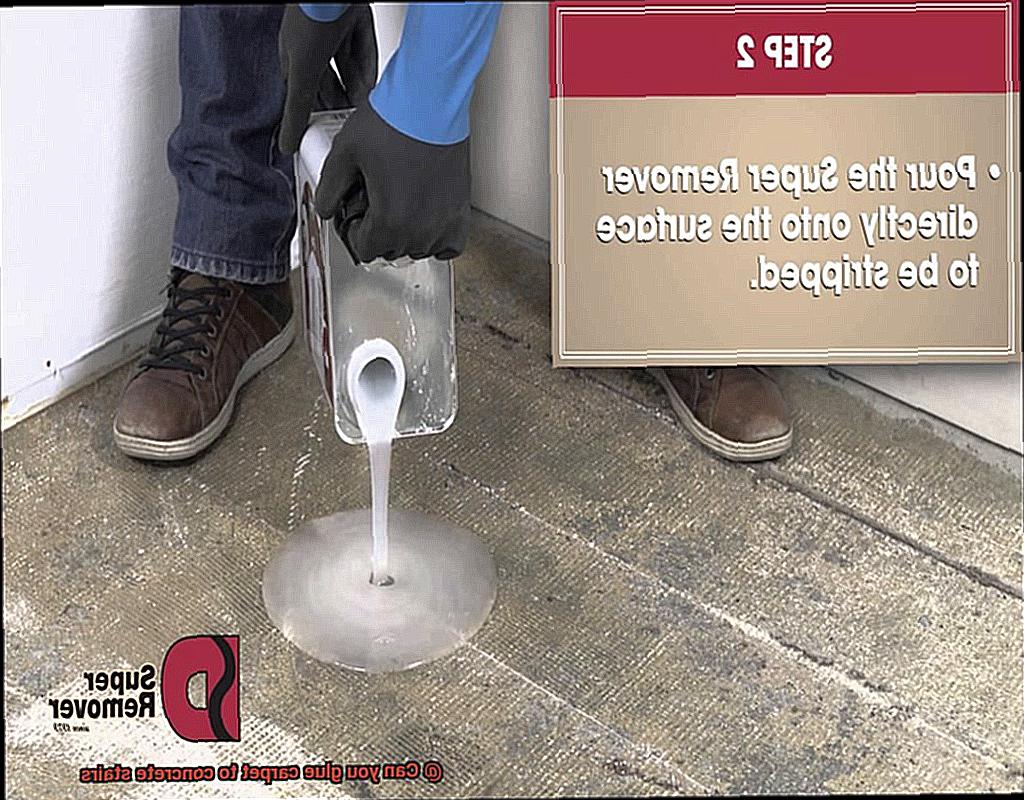
Now that you have your roller ready, it’s time to prepare the surface. Make sure the adhesive has been applied evenly onto the concrete stairs. Using a notched trowel or a similar tool, spread the adhesive to ensure proper coverage. This step is crucial for creating a strong bond between the carpet and the stairs.
With the adhesive in place, carefully lay the carpet onto the stairs, ensuring it aligns properly with the edges. Now it’s time to grab your roller and begin pressing down the carpet. Start at one end of the stairs and work your way to the other end. As you roll back and forth, apply even pressure to firmly bond the carpet fibers with the adhesive.
Pay special attention to any seams or edges of the carpet. These areas may require additional pressure to ensure proper adhesion. Roll over them multiple times, exerting enough pressure without causing any damage or uneven stretching.
As you roll over the entire surface of the carpet, take a step back and inspect for any visible wrinkles or bubbles. If you notice any, go back and apply additional pressure with the roller until they are eliminated. It’s essential to address these issues immediately to prevent tripping hazards or premature wear and tear.
When using a roller, maintaining a steady and controlled motion is key. Avoid using excessive force, as it may damage the carpet or cause it to stretch unevenly. With a little patience and the proper technique, you can achieve a professional and secure carpet installation that will last for years to come.
Curing Time and Avoiding Walking on the Carpeted Stairs Until Fully Set
Today, we delve into the captivating world of carpeted stairs and explore the significance of waiting until the recommended curing time has elapsed. So grab your adhesive roller and let’s embark on this enlightening journey.
Understanding Curing Time
Curing time, the period it takes for the glue used to adhere the carpet, is a critical factor in achieving a flawless installation. Let’s unravel its mysteries:
- Curing time refers to the duration required for the adhesive to fully set and bond the carpet to the stair surface.
- To determine the appropriate curing time, it is crucial to consult the manufacturer’s instructions for the specific adhesive being used.
- Different adhesives have varying drying and setting times, so there is no one-size-fits-all approach.
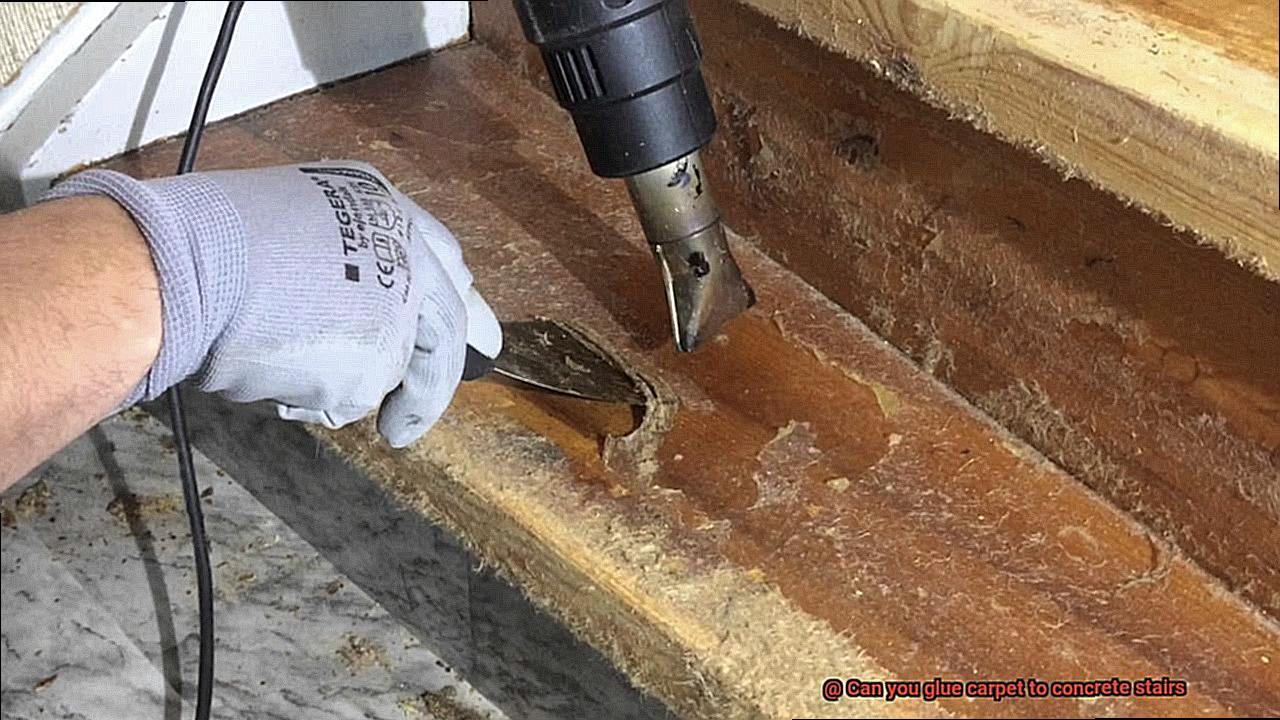
The Dangers of Premature Foot Traffic
Patience is key when it comes to walking on newly carpeted stairs before the glue has fully set. Here’s why:
- Premature foot traffic can cause the carpet to shift or come loose, creating an unstable walking surface that poses a safety risk.
- During this critical period, footprints or imprints left by eager souls can be difficult to repair once the glue has dried, compromising the aesthetics of your staircase.
- Safety should always take precedence, especially on stairs where a fall could result in severe injury.
Ensuring a Flawless Finish
Waiting until the specified curing time has passed is vital for achieving a durable and aesthetically pleasing outcome. Consider these steps:
- Allowing sufficient curing time enables the glue to bond securely with both the carpet and concrete surface, ensuring a steadfast installation.
- To avoid weakening or premature failure of the adhesive bond, it is advisable to refrain from placing heavy furniture or objects on the carpeted stairs until the glue has fully set.
- Temporary measures such as utilizing alternative staircases or applying protective coverings can provide a safeguard during the curing period.
The Art of Patience
By adhering to the recommended curing time, you are nurturing a masterpiece in the making:
- Patience during this process facilitates a durable and long-lasting installation that will withstand the test of time.
- Embrace the beauty and comfort of your newly transformed stairs, knowing that your patience has paid off in creating a secure, safe, and visually captivating environment.
swjF8CNa_xo” >
Also Read: How to Glue Carpet to Stairs?
Conclusion
Yes, you can absolutely glue carpet to concrete stairs.
It is a common and effective method for adding comfort, style, and safety to your staircase. By using a strong adhesive specifically designed for this purpose, you can securely attach the carpet to the concrete surface.
Gluing carpet to concrete stairs is a practical solution that can transform your staircase into a cozy and inviting space.

